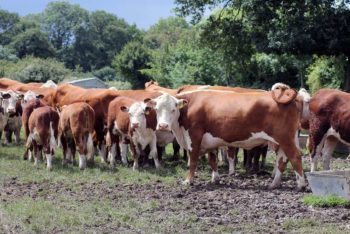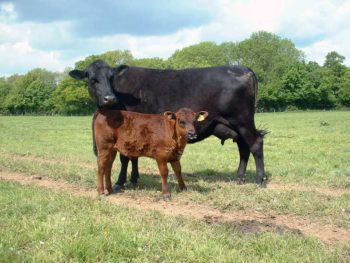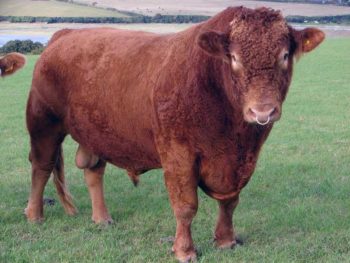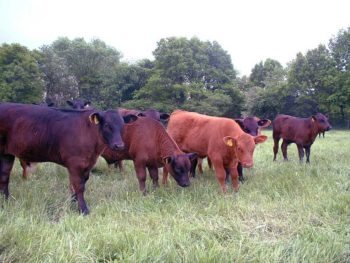23 Dec 2021
Matthew Dobbs BVM&S, CertCHP, GDL, ARAgS, MRCVS outlines various areas of law that may apply when such animals cause injury

Image: © ledina10 / Adobe Stock
With a recent rise in injuries (including fatal) caused by livestock, in this animal law article, Matthew Dobbs of www.farmlaw.co.uk outlines the areas of law that may apply when livestock cause injury to people.
Veterinary surgeons asked to provide opinion in cases of injury should have a basic understanding of the legislation, thereby helping to ensure the law is correctly applied, keeping the balance between appropriate protection of the public and the rights of the animal keeper.
The United Kingdom is covered by a vast network of public rights of way and footpaths. In addition to the 25,000km (15,534 miles) of roads, more than 241,600km (150,123 miles) of off-road rights of way, country footpaths, bridleways and byways exist.

With a growing health-conscious population, these rights of way are used by an increasing number of people. According to Department of Transport walking and cycling statistics, seventy-seven per cent of UK adults say they walk for pleasure at least once a month, while the Office for National Statistics states that walking is three times more popular than swimming – the second most participated activity – and that we each take 243 walks a year.
In addition, under the Countryside and Rights of Way Act 2000, the public can walk freely on approximately 865,000 hectares of mountain, moor, heath, downland and common land without following paths.
Maintaining access to the countryside promotes tourism and is important for the economy. According to the website VisitEngland, on trips to the English countryside in 2018 we spent somewhere in the region of £11.53 billion, supporting up to 245,000 full-time jobs.
However, access to the countryside is not risk free. In 2020-21, of the 42 fatalities in agriculture, forestry and fishing reported to the Health and Safety Executive, 11 were fatalities caused by livestock. In addition, 7 fatalities in the public were associated with agriculture over the same period, of which 4 were killed by cattle while walking.
Furthermore, the actual number of injuries caused by livestock is likely to be considerably higher as the reporting rate of incidents is thought to be less than five per cent. It is estimated that more than 5,000 members of the public are injured by livestock while walking in the countryside each year (personal communication with an expert witness in livestock injury cases).
For millennia, man has farmed animals for meat, milk, wool and leather. This close association between man and beast obviously yields the benefits of food and fibre; however, such a close association will, occasionally, result in harm done by farmed animals to both property and people.
Since the development of early law and through the middle ages, many specialised rules of liability for livestock were developed, under the application of the torts of nuisance, negligence and trespass, and two common law actions, the scienter action and cattle trespass.
The common law position allowed a person suffering damage caused by livestock redress either through these special rules of liability or through the principles of negligence.
Liability for livestock under the early law occurred in three main ways:

The scienter action – where the keeper of livestock was held strictly liable for injury to people or property, providing the animal was of a class of wild animals (ferae naturae) or tame animals (mansuetae naturae) providing the tame animals had a vicious propensity known to the keeper.
Cattle trespass, where the owner of “cattle” (actually most farmed livestock) was strictly liable for the injury they caused to the land, chattels or personal injuries to the occupier of the land.
Negligence where the general principle was that a keeper was under a duty to prevent his or her animal causing injury or damage, with the exception that the occupier of land adjoining a highway owed no duty of care to prevent their escape and no liability for injuries caused on the highway.
By the middle of the 20th century, complaints were made that the law protecting the public from livestock was uncertain and obscure, and that fine distinctions led to excessive complexity and unreasonable results. There was particular dissatisfaction that the law of negligence did not apply to the harm caused by livestock straying on to the highway.
Today, the public in the countryside are protected from physical injuries caused by animals, and by damage caused by infected animals (by spread of zoonotic disease) through statute and through common law.
The public is protected from damage, caused to persons or property by livestock, through the Animals Act 1971, the Occupiers Liability Act 1957, the Wildlife and Countryside Act 1981, the Highways Act 1980, and through common law actions of negligence and trespass.
The Animals Act 1971 introduced strict liability, based on classifying animals as dangerous or non-dangerous, replaced cattle trespass with statutory strict liability for straying livestock that cause damage and provided that an owner should be expected to exercise reasonable care to prevent livestock escaping on to the highway.
The act imposes a strict liability for damage caused by an animal that belongs to a dangerous species, identified as one not commonly domesticated within these islands, whose fully grown animals normally have such characteristics that they are likely, unless restrained, to cause severe damage, or that any damage they may cause is likely to be severe. Prospective alligator farmers take note.
Strict liability is also imposed where damage is caused by an animal that does not belong to a dangerous species, if:
the damage is of the kind which the animal, unless restrained, was likely to cause or which if caused by the animal, was likely to be severe
such likelihood was due to the characteristics of the animal not normally found in animals of the same species or, if so found, only at particular times or in particular circumstances.
Those characteristics were known to the keeper, or were at any time known to a person who at that time had charge of the animal as that keeper’s servant or, if the keeper is the head of a household, if he or she was known to any other member of the household under the age of 16 who is also deemed to be a keeper of the animal.
The effect of section 2(2) is that domesticated livestock species can be classified as dangerous if the keeper has knowledge of a dangerous characteristic. This is an area of law where vets are often called on to provide expert evidence.
A person is a keeper if he or she owns the animal or has it in his or her possession, or is head of the household of which a member under 16 owns the animal or has it in his or her possession, and if ownership ceases then the person immediately before that time qualifies as the keeper.
A person does not qualify as a keeper simply by taking it into possession to prevent it causing damage or to restore it to its owner.

The classification of a dangerous species, according to the act, is based on species and determined by precedent. Commonly domesticated species, such as cattle, are immediately excluded, which may be a surprise – especially with the common knowledge of the aggressive nature of some bovines, including bulls.
The legislation uses the word commonly, which will therefore include animals that are occasionally farmed, such as deer, even though the majority of deer in the UK are not domesticated and may also be accurately described as ferae naturate.
The meaning of domesticated, “accustomed to being kept by humans”, is likely to encompass all farmed livestock species and whatever propensity for aggression some farmed species may show, they are unlikely to satisfy a statutory definition of dangerous. With the rise in farming traditionally wild species such as venison and wild boar, this definition is open for challenge.
Non-dangerous species under the act include all farmed species in the UK and these are presumed harmless unless the statutory conditions laid down in 2(2) of the animals act are satisfied, when strict liability applies. It includes a wide range of incidents including injury or damage caused by livestock and the spread of infection.
The Court of Appeal made it clear that in interpreting section 2(2), that each of the requirements should be considered in turn. In addition, the likelihood (or foreseeability) of the damage should be “reasonably to be expected”.
For damage to be likely then the animal must have displayed this characteristic previously. The livestock keeper must have known or witnessed this characteristic. The likelihood of the damage, if caused, must also be severe. This is likely to be the case when dealing with large farmed ruminants such as cows and bulls, but is also the case for small species with the ability or aggression to cause injury – for exmple, a bantam cockerel.
The damage should also be caused by the animal. An injury sustained while running away from livestock would also be deemed to have been caused by the animal. The damage need not be of the kind the animal was likely to cause, only that it needs to be severe.
The definition of damage is defined in sections 10 and 11, and includes death, where a victim’s dependant has the right of action under the Fatal Accidents Act 1976. It also includes “any disease and any impairment of physical or mental condition”. This could include damage following zoonotic disease such as Escherichia coli 0157 and salmonella, although cases of E coli 0157 have recently been brought through breach of Control of Substances Hazardous to Health Regulations 1999 instead.
A recent rise in claims has occurred, particularly against open-access farms, and with the greater exposure of people to potential pathogens on public footpaths in the countryside this legislation offers potential claimants that contract a zoonotic disease, from known infected stock (for example salmonellosis, leptospirosis) an action.
The likelihood of damage must also be due to characteristics not normally found in that species, except in particular times and circumstances. This authority has been developed in accordance with the literal meaning. Therefore, regarding livestock, a cow seeking out its calf was held as a normal characteristic, but excessive agitation leading to “behaviour of an excited wild animal” could not be described as a normal characteristic.
This was confirmed when a cow with a calf at foot, at turnout in the spring, aggressively attacked a walker. The aggressive characteristics were deemed to be associated with the particular time and circumstances of the incident, and the farmer was liable.
The case in Mirvahedy v Henley was a clear landmark in that the burden of responsibility and risk was placed with the animal keeper. This case detailed where the liability for damage caused by horses that had escaped their field should lie. Following this case the NFU and Country Landowners Association (CLA) have expressed concern about the insurance impact for animal keepers in the countryside, and have (unsuccessfully) lobbied several times for an amendment to the 1971 Animals Act.
This burden was further confirmed in McKaskie v Cameron, where Ms McKaskie was injured while walking her dog near cows with calves at foot. Dogs have been recognised by the NFU as a potential stimulus of aggressive behaviour in cows, yet in this case, where the farmer had knowledge of the aggressive tendency, he was held liable for the behaviour of his cattle. If this case provides precedence, the burden of responsibility clearly lies with the keeper of the animals and not the public.
Knowledge, or vicarious knowledge, of the animal’s actual abnormal characteristic is required. In McKenny v Forster, the exceptional characteristic of the cow in question, enabling it to jump a six-bar gate in extreme agitation, was not known and the keeper was not held to be liable. For liability the keeper must have known the animal to have previously caused the same damage, attempted the harm or simply know that the animal has a characteristic that will make it aggressive.
The keeper will also be held liable if the abnormal characteristics were known at any time to a person in charge of the animal, to the keeper’s servant, or where they were known to a member of the household who is under 16. In modern farming practices, where it is common for a farm business to employ staff, this places liability on a herd owner where, for example, a stockman knows about the characteristic of an animal, but may be unknown to the registered keeper. This is an extension of the master/servant relationship held for cattle droving.
The duty of the keeper for the animal’s behaviour extends from the defendant’s land to the highway or a third party’s land. The animal also need not have escaped the keeper’s control, or indeed for the animal to have undertaken an attack, for liability to be affirmed.
The claimant’s knowledge of the dangerous characteristic alone will not suffice for an adequate defence. For voluntary assumption of risk to apply, signs declaring entrance at own risk may allow a suitable defence; however, it is an offence to display signs that deter the public from using a footpath by including any false or misleading statements. Furthermore, using terms that would provide an effective warning may also be construed as admitting that the animals are dangerous.
The presence of a dog is a significant risk in cases of walkers being attacked by cattle. However no voluntary assumption exists of risk by dog walkers on public fields containing livestock. The NFU recommends livestock keepers place a sign saying “your dog can scare or harm farm animals – keep it on a lead around livestock, but let go if chased by cattle” wherever walkers have access to livestock fields.
Trespassing is a potential defence, and the issue of liability for injuries to trespassers is dealt with specifically by section 5(3) of the Animals Act 1971, indicating that a keeper is not liable for any damage caused by an animal to a person trespassing, where the animal is not kept for protection or persons or property or if it was kept for protection of persons or property, that the purpose was not unreasonable. This exclusion covers the vast majority of livestock in the UK.
However, one livestock species is kept for protection purposes. The llama is used for the protection of smaller ruminants – usually sheep. The use of this South American camelid as a guard for smaller ruminants is a relatively recent development and no authority appears to exist on whether a member of the public injured while trespassing by the unreasonable use of a llama to protect sheep would be held.
Damage that is wholly due to the fault of the claimant is detailed in section 5(1) of the Animals Act 1971, which states: “A person is not liable under sections 2 to 4 of this act for any damage which is due wholly to the fault of the person suffering it.”
For this defence the claimant must be shown to be wholly at fault, and the claimant must be aware of both the existence of the animal and its dangerous characteristic. The walking of a dog in a field of cattle, where a claimant may have known that the presence of a dog would provoke aggression in the cows, was not held as a valid determination of whole fault.
Possible opportunities to apply this defence include claims by people who have voluntarily entered confined areas where livestock are present, without adequate means of restraint or escape and when attempting to drive livestock, for example into another field. However, in the latter circumstance, if the dangerous characteristics are known to the defendant then unless the claimant acted unreasonably, the defence will not hold.
Since the 17th century there has been a common law duty to take reasonable care to prevent your animals from causing injury. This is in addition to any statutory obligation, such as under the Animals Act 1971.
All elements of the tort of negligence – being duty of care, breach, causation and a reasonable foreseeable damage – are required.
Unlike the strict liability under the Animals Act 1971, liability is based on reasonable foresight. Any pre-existing knowledge of the dangerous characteristic is not necessarily required. Under an action of negligence, liability depends on fault and is not limited to the keeper of the animals, but can extend to anyone who cares for the animal.
A flexible application of negligence is open to the public injured by livestock, and many situations lend themselves to the application of a duty of care. Livestock on the highway, allowing diseased animals to escape, allowing a known aggressive animal to run loose and even where animals are kept in excessive numbers without due care are all examples where a duty exists.
In McKaskie v Cameron the defendant was found to owe a duty of care where he knew about the propensity of his cows to aggression and where he knew that inciting factors, such as first turnout in the spring, placing the cattle in unfamiliar surroundings in a new field, with their calves at foot, would likely enhance the probability of the cattle expressing this aggressive behaviour.
Where a claimant is injured by the defendant’s animal while on the defendant’s land as a lawful visitor then the obligations of the occupier are governed by the Occupiers Liability Act 1984.
The likely situations for application of the act are injuries caused by non-dangerous species, such as livestock, where the occupier ought to have reasonable care for the safety of his lawful visitors and a foreseeable risk of harm, against which no preventive steps are taken.
Under the act, an occupier also owes a trespasser a duty, to take such care as is reasonable to prevent injury due to things done or omitted to be done. For this duty to be held, the occupier must be aware the danger exists, have grounds to believe a trespass may occur and the risk is one he may reasonably be expected to afford some protection. The same duty is owed under the Countryside and Rights of Way Act 2000, where a claimant may be “roaming” away from a designated highway.
Under the Wildlife and Countryside Act 1981, an occupier of a field crossed by a right of way may not allow a bull to be at large. Exceptions are granted for bulls younger than 10 months of age and for bulls of breeds not recognised as dairy breeds, which are kept with cows or heifers.
This legislation is to protect the public from the known increased aggressive characteristics demonstrated by dairy breeds of bull. However, the legislation already appears outdated, as the statute describes recognised dairy breeds is limited to seven breeds .
Section four of the Animals Act 1971 provides an opportunity for the occupier of land on to which livestock strays to claim, but not for the innocent passer-by injured or sustaining damage while on a public right of way by a straying animal.

Previously, the general rule confirmed in Searle v Wallbank was that an occupier of land was under no duty to fence land off from the highway and no negligence would be found if straying livestock caused injury to users of the highway. This rule was seen as “an outrageous subsidy shamelessly exacted by the farming lobby at the expense of public safety”.
Once this rule was abolished by the Animals Act in 1971, livestock straying on to the highway due to negligence and causing damage or injury, or where an animal has lawfully been taken on to the highway causes damage due to negligence by the keeper, or where animals that stray off the highway causes damage due to negligence by the keeper, then liability in negligence may occur.
This negligence may include poorly maintained fences, failure to check fences regularly and even (following a case in Ireland), where a fence appears without defect, but where cattle are still able to escape, through the doctrine res ipsa loquitur (where the mere occurrence is sufficient to imply negligence). The definition of highway is to include all rights of way, including footpaths across fields .
Under the Highways Act 1980, it is also a criminal offence to allow horses, cattle, sheep, goats or swine to stray on the highway.
With ever-greater access to the countryside, the opportunity for, and prevalence of, injury and damage to the public continues to rise.
To reverse the current rise in injuries (including fatal), the law is developing to increase the burden on the livestock keeper, who are seen as best placed to assess the risks posed by their stock, and also have the opportunity to mitigate this risk through management and insurance.
Many believe the Animals Act 1971 did not do enough to rid the law of complexity, by retaining specialised categories of liability, and relying on complicated definitions of dangerous and non-dangerous species. A partial repeal of the Animals Act 1971 could give greater application to the principles of common law negligence and would lead to a simpler, more certain approach.
Vets may often get asked to provide expert opinion when livestock species cause injury to people. A basic understanding of the law associated with this request can ensure that they provide meaningful insight to help assess whether liability exists.